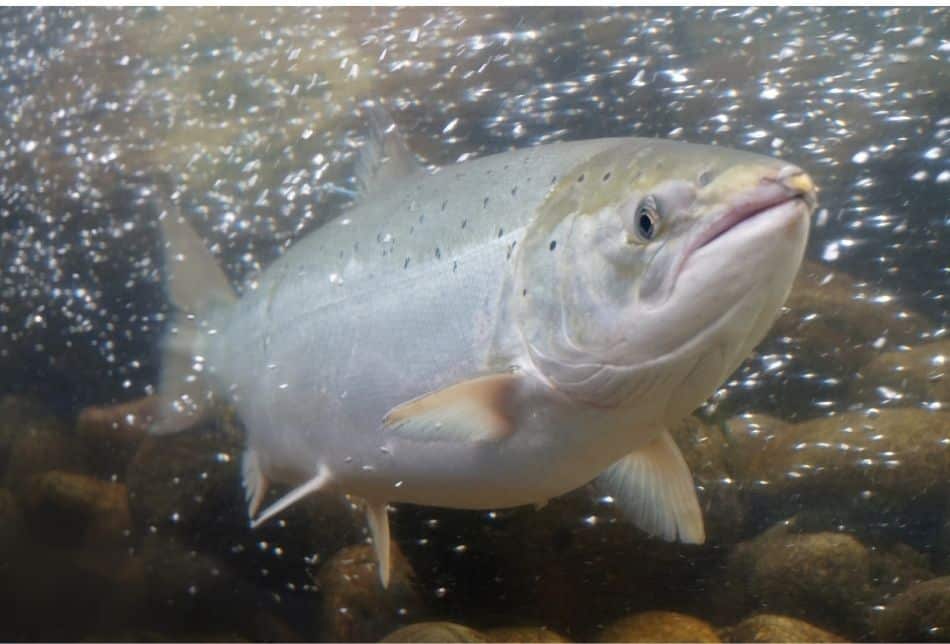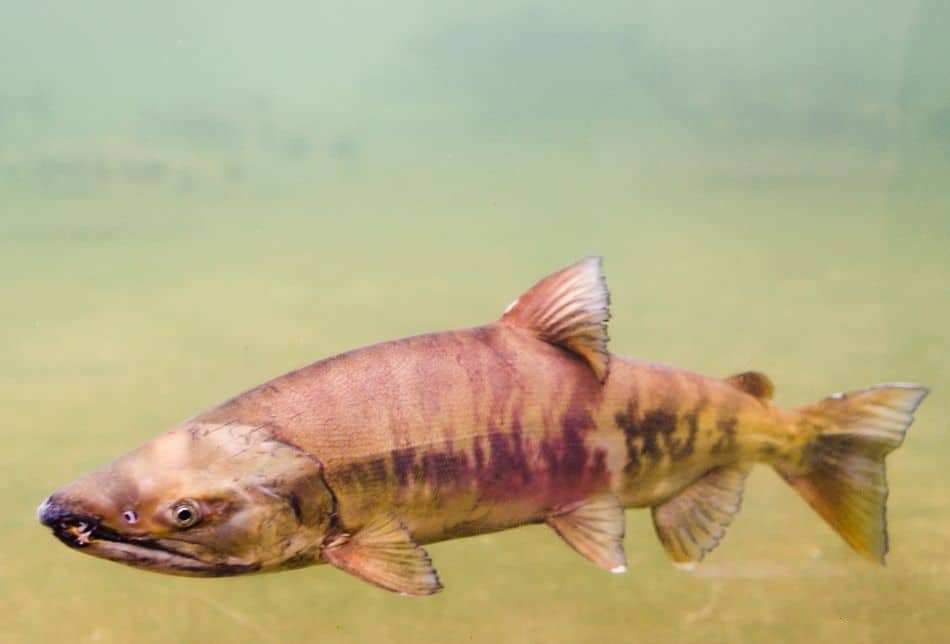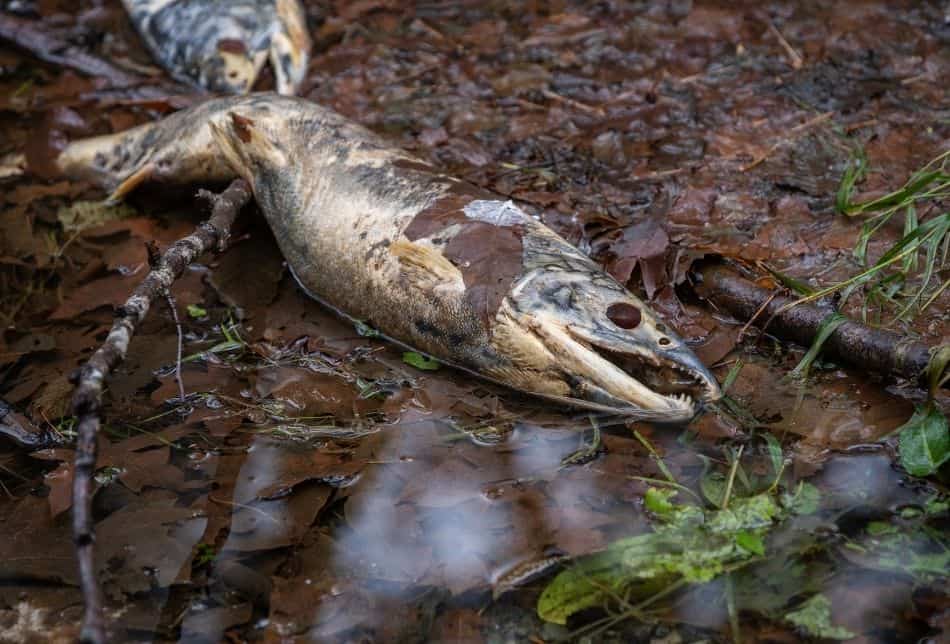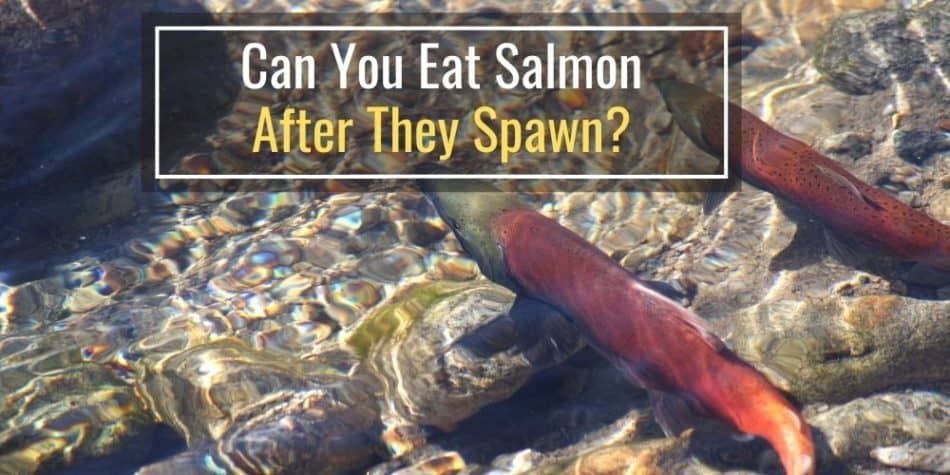Salmon are amazing fish. There are few creatures on this planet that can be found in both freshwater and saltwater.
Adult salmon will leave the ocean and swim back up rivers to find the exact same spawning location where they began their journeys.
Given that adult salmon can weigh in at over 60 pounds, it’s no wonder why many folks try to fish for these large fish for their size, fight, and tasty fillets.
However, salmon fishing is some of the more difficult fishing to be successful at. So it can be tempting to catch a salmon after the salmon spawns since the fish turn very docile and can even be caught with your bare hands.
This begs the question, can you eat salmon after they spawn?
Generally, salmon should not be eaten after they have spawned. Most salmon that are close to or have already spawned will have bodies that have deteriorated and have a mushy texture.
Now let’s cover some signs that indicate when a salmon may not be good to eat.
What Causes Salmon To Swim Up Rivers?
After salmon spend their early years in rivers and streams, the salmon move to the sea during adulthood. Once the salmon have reached a certain age, an urge to spawn kicks in.
The salmon will begin to migrate from the ocean back up the rivers from where they were born.
It’s worth noting that different breeds of salmon spawn at different times of the year. However, several environmental factors like water temperature and rainfall can alter the exact date and time that the salmon will start their runs back to their spawning location.
Once the salmon reach their spawning location, they will spawn by releasing gametes into the surrounding water for fertilization. For most species, spawning is the final act before dying. For salmon, all the salmon will die shortly after depositing their eggs and semen in the spawning location.
Now that we know the great trek that salmon undertake to spawn, this begs the question: do spawning salmon taste differently?
Does Spawning Salmon Taste Different?
Salmon is full of protein and omega-3 fatty acids and is thus often considered to be an extremely healthy part of a healthy diet
However, as salmon migrate into freshwater streams to spawn, their bodies begin to degrade and decompose. So any spawning salmon will taste worse and have a mushier texture than salmon caught in the ocean.
That takes us to our next question.
How To Tell Spot A Spawning Salmon
A salmon that starts traveling back to the spawning location only has one thing on its mind. Any salmon that reaches adulthood and spawning age will begin to transform and allocate all their body’s nutrients to spawning.
Here are a few signs and symptoms that will help you identify if a salmon is a spawning salmon:
- Round Belly. Females will have large round bellies full of eggs. When touching a female spawning salmon, the belly will be very soft and mushy.
- Hooked Jaw. A spawning male develops a noticeable hook around its jaw, known as a “hook”.
- Coloration. Younger salmon will appear more silvery in color whereas mature salmon may have brighter yellow and red markings. These colorations and markings will vary based on the specific salmon breed but adults will have more intense colorations and markings compared to juveniles.
- Ovipositor. Not an easy thing to spot, but female spawning salmon will develop a protrusion at their anus. This tubular organ is where the female will deposit the eggs from.
So when looking at a juvenile salmon, it’s easy to confuse these fish with trout:

However, as soon as a male juvenile salmon turns into an adult, the physical transformation is more noticeable with the beaked mouth and coloration change:

After the salmon spawn, they will die shortly after and begin rotting:

So most salmon that are close to or have already spawned will have bodies that have deteriorated and have a mushy texture which will not be tasty. Technically salmon that spawned are still edible but the taste and texture will be off.
Why Do Salmon Change Color After They Spawn?
The color of a salmon’s flesh is determined by what they eat. The carotenoid pigment in their diet gives them their reddish hue (from the food they consume in the ocean) and this reddish pigment gets stored in their flesh.
These carotenoid pigments are then slowly transferred to their skin and eggs, thus gradually darkening their bodies, so when it’s time for them to spawn finally, their bodies have become essentially red due to the decreased presence of carotenoids. Not only does this process signal others that it is time for sexual reproduction, but this also helps salmon absorb oxygen from water as well.
For instance, when king salmon adults are ready to mate, they change their appearance from silver and bright to maroon or olive-brown. In contrast, coho salmon adults turn greenish-black when mating season is on the horizon. Sockeye salmon adults start a dull green before changing into brick-red or scarlet during mating.
Can You Eat Dying (Spawned) Salmon?
Avoid eating any salmon that has already spawned since these salmon will have rotting flesh. The rotting salmon flesh will be full of bacteria, and unpleasant mushy textures from the rotting flesh including pus pockets.
So do not eat any salmon that feels mushy or has an off odor. At this point, the spawned salmon is rotting and will not be edible.
Final Thoughts
Now that we understand why salmon look differently in the ocean versus the adults returning to their spawning ground, we can see why we should not eat salmon that spawned.
So although it might technically be possible to consume a salmon that spawned; they may not be as flavorful or tender as the unspawned batches. Males, in particular, undergo an exciting transformation from silvery fats and fatty fish into humpbacked hooked jaws.
Through this transformation, the salmon devotes all its energy and resources to spawning. Ultimately, the salmon’s body starts deteriorating the moment the fish begins to focus on spawning.
So stick to the fresh ocean-caught salmon and salmon near river mouths since these salmon will not have had enough time to allow their bodies to deteriorate.
Once a salmon spawns, do not eat this salmon since their bodies will be rotting.
Frequently Asked Questions
Could I Save A Salmon After Spawning With Expert Care, Or Are The Changes Irreversible?
If you happen to catch a Pacific salmon, you might be able to prolong its life with expert care. However, it is probably best for everyone involved if the salmon can die a natural death. The reality is that it has already entered into a state of decay, and all its major systems, such as digestive, respiratory, and reproductive functions, among others, have all begun shutting down. This type of salmon usually has no way to recover from this state.
However, you cannot save a wild salmon as a wild salmon will die almost immediately after spawning.
Do Salmon Die After Spawning?
When salmon swim upstream to breed, they are facing a tough challenge. They have to swim against a strong current, and their energy is drained. Since spawning involves depositing eggs in the stream bed, which takes quite some effort, these fish do not eat for up to two weeks after spawning. Their bodies deteriorate soon after breeding, and most die within two days, except the Alaskan sockeye that can live up to eight days post-spawning.
Why Do The Jaws Change Shape During And After Spawning?
The Atlantic salmon’s skull undergoes several changes during development. First, blood vessels develop to bring nutrients and oxygen to the developing kype (“crow-bar” shaped growth on a male’s head). This causes the bones in the vicinity of this growth to thicken.
Then, ossification causes their facial bones to harden, and their jaws conform to the shape of their kype. Their cheekbones also develop into “hard teeth” called conules. Finally, scales begin breaking out at the back half of their body during development and resorption (thinning away) at the front half of their body; only males are affected by these changes in appearance.

